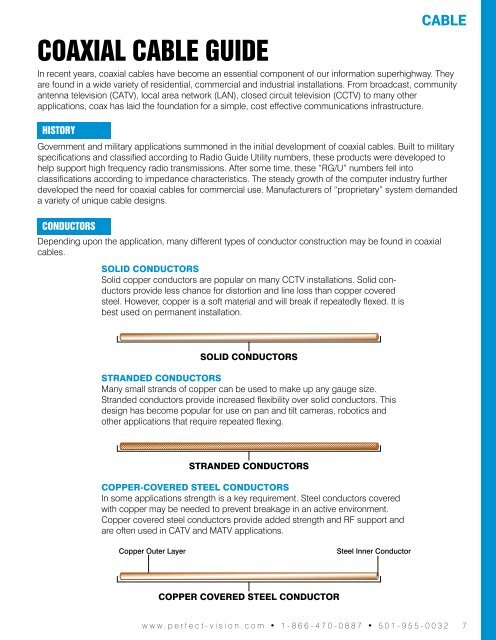INTL-Catalog35web
INTL-Catalog35web
INTL-Catalog35web
Create successful ePaper yourself
Turn your PDF publications into a flip-book with our unique Google optimized e-Paper software.
Cable<br />
Coaxial Cable Guide<br />
In recent years, coaxial cables have become an essential component of our information superhighway. They<br />
are found in a wide variety of residential, commercial and industrial installations. From broadcast, community<br />
antenna television (CATV), local area network (LAN), closed circuit television (CCTV) to many other<br />
applications, coax has laid the foundation for a simple, cost effective communications infrastructure.<br />
History<br />
Government and military applications summoned in the initial development of coaxial cables. Built to military<br />
specifications and classified according to Radio Guide Utility numbers, these products were developed to<br />
help support high frequency radio transmissions. After some time, these “RG/U” numbers fell into<br />
classifications according to impedance characteristics. The steady growth of the computer industry further<br />
developed the need for coaxial cables for commercial use. Manufacturers of “proprietary” system demanded<br />
a variety of unique cable designs.<br />
conductors<br />
Depending upon the application, many different types of conductor construction may be found in coaxial<br />
cables.<br />
Solid Conductors<br />
Solid copper conductors are popular on many CCTV installations. Solid conductors<br />
provide less chance for distortion and line loss than copper covered<br />
steel. However, copper is a soft material and will break if repeatedly flexed. It is<br />
best used on permanent installation.<br />
Solid Conductors<br />
stranded Conductors<br />
Many small strands of copper can be used to make up any gauge size.<br />
Stranded conductors provide increased flexibility over solid conductors. This<br />
design has become popular for use on pan and tilt cameras, robotics and<br />
other applications that require repeated flexing.<br />
stranded Conductors<br />
Copper-covered Steel Conductors<br />
In some applications strength is a key requirement. Steel conductors covered<br />
with copper may be needed to prevent breakage in an active environment.<br />
Copper covered steel conductors provide added strength and RF support and<br />
are often used in CATV and MATV applications.<br />
Copper Outer Layer<br />
Steel Inner Conductor<br />
Copper covered steel conductor<br />
www.perfect-vision.com • 1-866-470-0887 • 501-955-0032 7


